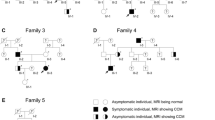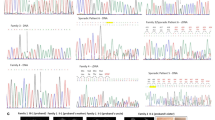Abstract
Cerebral cavernous malformations (CCMs) represent a common autosomal dominant disorder that predisposes patients to hemorrhagic strokes and focal neurological signs. Mutations in three genes (KRIT1, MGC4607, and PDCD10) have been associated with CCMs. We investigated the role of two new mutations in the KRIT1 gene in two Italian families affected by CCMs. Whole blood DNA was extracted and the mutations were detected after polymerase chain reaction (PCR), denaturing high-performance liquid chromatography screening, and sequencing of the coding regions of the three CCMs-associated genes. Total RNA was extracted, and the KRIT1 cDNA was sequenced and subsequently subjected to real-time quantitative PCR in order to examine the translational outcome of each genomic mutation. A novel splicing acceptor site deletion of the exon 14 in one family and an intronic nucleotide change close to the exon 19 in the other one were identified, both in the KRIT1 gene. These mutations were proven to alter the correct splicing mechanism, resulting, respectively, in a truncated protein of 432 amino acids and in a protein lacking an internal segment. We report two novel cases of splicing affecting genomic variants, suggesting a careful reanalysis of previously identified splice site variations in KRIT1 to look for their possible causative roles of similar missplicing events and their consequent involvement in the pathogenesis of CCMs. Moreover, our genotype–phenotype functional correlation suggests that the C-terminal portion of the KRIT1 protein is likely to contain a short, previously unrecognized segment necessary for its activity.





Similar content being viewed by others
References
Russel DS, Rubinstein LJ (1990) Pathology of tumors of the nervous system, 5th edn. Williams & Wilkins, Baltimore, MD
Labauge P, Laberge S, Brunereau L, Levy C, Tournier-Lasserve E (1998) Hereditary cerebral cavernous angiomas: clinical and genetic features in 57 French families. Societe Francaise de Neurochirurgie. Lancet 352:1892–1897
Rigamonti D, Hadley MN, Drayer BP, Johnson PC, Hoenig-Rigamonti K, Knight JT, Spetzler RF (1988) Cerebral cavernous malformations. Incidence and familial occurrence. N Engl J Med 319:343–347
Otten P, Pizzolato GP, Rilliet B, Berney J (1989) 131 cases of cavernous angioma (cavernomas) of the CNS, discovered by retrospective analysis of 24,535 autopsies. Neurochirurgie 35:82–3, 128–131
Craig HD, Gunel M, Cepeda O, Johnson EW, Ptacek L, Steinberg GK, Ogilvy CS, Berg MJ, Crawford SC, Scott RM, Steichen-Gersdorf E, Sabroe R, Kennedy CT, Mettler G, Beis MJ, Fryer A, Awad IA, Lifton RP (1998) Multilocus linkage identifies two new loci for a mendelian form of stroke, cerebral cavernous malformation, at 7p15–13 and 3q25.2–27. Hum Mol Genet 7:1851–1858
Denier C, Labauge P, Brunereau L, Cave-Riant F, Marchelli F, Arnoult M, Cecillon M, Maciazek J, Joutel A, Tournier-Lasserve E; Societe Francaise de Neurochirgurgie; Societe de Neurochirurgie de Langue Francaise (2004) Clinical features of cerebral cavernous malformations patients with KRIT1 mutations. Ann Neurol 55:213–220
Laberge-Le Couteulx S, Jung HH, Labauge P, Houtteville JP, Lescoat C, Cecillon M, Marechal E, Joutel A, Bach JF, Tournier-Lasserve E (1999) Truncating mutations in CCM1, encoding KRIT1, cause hereditary cavernous angiomas. Nat Genet 23:189–193
Liquori CL, Berg MJ, Siegel AM, Huang E, Zawistowski JS, Stoffer T, Verlaan D, Balogun F, Hughes L, Leedom TP, Plummer NW, Cannella M, Maglione V, Squitieri F, Johnson EW, Rouleau GA, Ptacek L, Marchuk DA (2003) Mutations in a gene encoding a novel protein containing a phosphotyrosine-binding domain cause type 2 cerebral cavernous malformations. Am J Hum Genet 73:1459–1464
Bergametti F, Denier C, Labauge P, Arnoult M, Boetto S, Clanet M, Coubes P, Echenne B, Ibrahim R, Irthum B, Jacquet G, Lonjon M, Moreau JJ, Neau JP, Parker F, Tremoulet M, Tournier-Lasserve E, and Société Française de Neurochirurgie (2005) Mutations within the programmed cell death 10 gene cause cerebral cavernous malformations. Am J Hum Genet 76:42–51
Verlaan DJ, Roussel J, Laurent SB, Elger CE, Siegel AM, Rouleau GA (2005) CCM3 mutations are uncommon in cerebral cavernous malformations. Neurology 65:1982–1983
Sambrook J, Fritsch EF, Maniatis T (1989) Molecular cloning: a laboratory manual, 2nd edn. Cold Spring Harbor Laboratory, NY
Davenport WJ, Siegel AM, Dichgans J, Drigo P, Mammi I, Pereda P, Wood NW, Rouleau GA (2001) CCM1 gene mutations in families segregating cerebral cavernous malformations. Neurology 56:540–543
Fairbrother WG, Yeh RF, Sharp PA, Burge CB (2002) Predictive identification of exonic splicing enhancers in human genes. Science 5583:1007–1013
Reese MG, Eeckman, FH, Kulp, D, Haussler, D (1997) Improved splice site detection in genie. J Comp Biol 4:311–323
Baralle D, Baralle M (2005) Splicing in action: assessing disease causing sequence changes. J Med Genet 42:737–748
Cartegni L, Wang J, Zhu Z, Zhang MQ, Krainer AR (2003) ESEfinder: a web resource to identify exonic splicing enhancers. Nucleic Acids Res 31:3568–3571
Zawistowski JS, Serebriiskii IG, Lee MF, Golemis EA, Marchuk DA (2002) KRIT1 association with the integrin-binding protein ICAP-1: a new direction in the elucidation of cerebral cavernous malformations (CCM1) pathogenesis. Hum Mol Genet 11:389–396
Zawistowski JS, Stalheim L, Uhlik MT, Abell AN, Ancrile BB, Johnson GL, Marchuk DA (2005) CCM1 and CCM2 protein interactions in cell signaling: implications for cerebral cavernous malformations pathogenesis. Hum Mol Genet 14:2521–2531
Cave-Riant F, Denier C, Labauge P, Cecillon M, Maciazek J, Joutel A, Laberge-Le Couteulx S, Tournier-Lasserve E (2002) Spectrum and expression analysis of KRIT1 mutations in 121 consecutive and unrelated patients with cerebral cavernous malformations. Eur J Hum Genet 10:733–740
den Dunnen JT, Antonarakis SE (2000) Mutation nomenclature extensions and suggestions to describe complex mutations: a discussion. Hum Mutat 15:7–12
Verlaan DJ, Siegel AM, Rouleau GA (2002) KRIT1 missense mutations lead to splicing errors in cerebral cavernous malformation. Am J Hum Genet 70:1564–1567
Laurans MSH, DiLuna ML, Shin D, Niazi F, Voorhees JR, Nelson-Williams C, Johnson EW, Siegel AM, Steinberg GK, Berg MJ, Scott RM, Tedeschi G, Enevoldson PT, Anson J, Roluleau GA, Ogilvy C, Awad IA, Lifton RP, Gunel M (2003) Mutational analysis of 206 families with cavernous malformations. J Neurosurg 99:38–43
Verlaan DJ, Davenport WJ, Stefan H, Sure U, Siegel AM, Rouleau GA (2002) Cerebral cavernous malformations: mutations in KRIT1. Neurology 58:853–857
Kehrer-Sawatzki H, Wilda M, Braun VM, Richter HP, Hameister H (2002) Mutation and expression analysis of the KRIT1 gene associated with cerebral cavernous malformations (CCM1). Acta Neuropathol (Berl) 104:231–240
Puntervoll P, Linding R, Gemund C, Chabanis-Davidson S, Mattingsdal M, Cameron S, Martin DM, Ausiello G, Brannetti B, Costantini A, Ferre F, Maselli V, Via A, Cesareni G, Diella F, Superti-Furga G, Wyrwicz L, Ramu C, McGuigan C, Gudavalli R, Letunic I, Bork P, Rychlewski L, Kuster B, Helmer-Citterich M, Hunter WN, Aasland R, Gibson TJ (2003) ELM server: a new resource for investigating short functional sites in modular eukaryotic proteins. Nucleic Acids Res 31:3625–3630
Gault J, Shenkar R, Recksiek P, Awad IA (2005) Biallelic somatic and germ line CCM1 truncating mutations in a cerebral cavernous malformation lesion. Stroke 36:872–874
Pagani F, Baralle FE (2004) Genomic variants in exons and introns: identifying the splicing spoilers. Nat Rev Genet 5:389–396
Nakai K, Sakamoto H (1994) Construction of a novel database containing aberrant splicing mutations of mammalian genes. Gene 141:171–177
Krawczak M, Reiss J, Cooper DN (1992) The mutational spectrum of single base-pair substitutions in mRNA splice junctions of human genes: causes and consequences. Hum Genet 90:41–54
Acknowledgements
We acknowledge the families who participated in this study. We also gratefully acknowledge Prof. Antonio M. Persico for his essential help in the revision of this manuscript. This work was supported by grants from the Italian Ministry of Health (Ricerca Corrente 2004). V.G. was supported by a fellowship from the Italian Ministry of Health (Ricerca Corrente 2004). The authors declare no conflict of interest and declare that all the experiments of this work comply with the Italian current laws.
Author information
Authors and Affiliations
Corresponding authors
Additional information
Vito Guarnieri and Lucia A. Muscarella have contributed equally to this work.
Rights and permissions
About this article
Cite this article
Guarnieri, V., Muscarella, L.A., Amoroso, R. et al. Identification of two novel mutations and of a novel critical region in the KRIT1 gene. Neurogenetics 8, 29–37 (2007). https://doi.org/10.1007/s10048-006-0056-y
Received:
Accepted:
Published:
Issue Date:
DOI: https://doi.org/10.1007/s10048-006-0056-y




